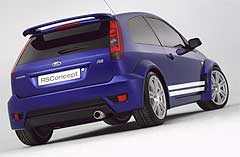First look: Fast Fiestas poised to fly
BY BYRON MATHIOUDAKIS | 26th Mar 2004

Dubbed RS (for "Rallye Sport"), it will top the Fiesta family in price (around $A38,000) and power output (estimated to be between 135kW/180bhp and 149kW/200bhp) when it hits European roads later next year.
The company says its 0-100km/h sprint should at least match the new Renaultsport Clio 182’s 7.1-second figure.
Ford Australia is considering the RS to add to its recently launched local range, although a spokesperson said it was too early to indicate when a decision would be made. The usual costing and feasibility hurdles have yet to be cleared.
Driving the RS’ front wheels is a variation of the 2.0-litre twin cam Duratec HE four-cylinder engine found in the European Mondeo that we miss out on.
However, unlike the recently deceased Focus RS, a turbocharger will not be employed, to ensure its price and insurance ratings are kept reasonable. Nevertheless, the word is that the cooling system is able to cope with one.
Other mechanical modifications include lower springs, revised dampers and an altered steering ratio, although the main suspension hardware remains stock Fiesta.

Ford has hit its heritage cupboard hard with the RS, nabbing the name, be-spoilered appearance and "Performance Blue" paintwork from the Focus RS – itself a visual progeny of its Escort RS predecessors – while the twin white side stripes are pure Ford GT/GT40.
The Fiesta RS joins the Clio 182 and recently released Peugeot 206 GTI 180 in what Renault in Europe has described as "a pissing match with Peugeot".
Other hot hatches include BMW’s Mini Cooper S, the oddball turbo-diesel Skoda Fabia vRS, as well as an upcoming Opel Corsa (nee Holden Barina) believed to be powered by a turbocharged 1.6-litre engine.
The last Fiesta with the RS badge was the RS1800 of 1995.
The RS has kicked the other fast Fiesta unfurled at the show – the ST – out of the limelight.
Standing for "Sport Technologies", the three-door only ST features a detuned version of the RS’ 2.0-litre unit that pumps out 111kW of power.
Ford promises that the ST will also have a level of performance chassis tuning that is "designed to give small-car drivers something to smile about".
The ST also features a sporty makeover, with bumpers, side skirts and 17-inch alloy wheels, while inside there are racing style seats, metal trim on the console and on the pedals, and leather upholstery.
Also on Ford Australia’s wish list for next year, the sub-$30,000 ST is scheduled for a November 2004 European debut.
Ford, a pioneer of the baby hot hatch, in doing so is returning to a market that it imprudently abandoned.
Its 1981 Fiesta XR2, based on both earlier generation models unseen here, became an icon in the UK for a decade, where 34,000 were sold.
But more sophisticated buyer tastes, exorbitant insurance premiums and the return of the Mazda MX-5-fuelled cheap convertible during the early 1990s kept buyers at bay, eventually leading to the XR2’s axing.
Citroen then successfully moved in with its Peugeot 106-derived Saxo VTR/VTS, inheriting a fickle teenage demographic Ford would kill for. The niche is now the temporary domain of the MG ZR (a three-door Rover 25 in drag with ancient Honda Civic underpinnings), now that the sexy Saxo is dead and its C2 replacement is just now coming on stream.
With both its fast Fiestas, Ford is fixing for a fight.